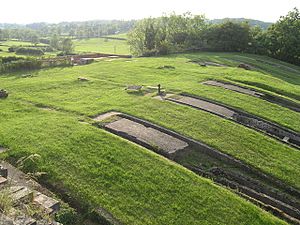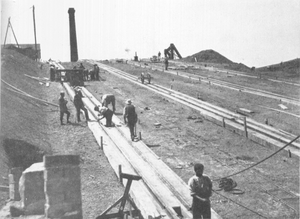Foxton Inclined Plane Trust facts for kids
The Foxton Inclined Plane Trust is a special group that works to protect and restore old waterways. It is a charity in Foxton, Leicestershire, England, UK. The Trust started in 1980. Its main goal is to help bring back the amazing Victorian boat lift at Foxton. This boat lift, also called an inclined plane, is a very important part of canal history.
The Trust also runs the Foxton Canal Museum. This museum opened in 1989 and is the main office for the Trust. It is located in the old boiler house of the inclined plane. The Trust is actively working to fully restore the boat lift. It is part of a group called the Foxton Locks Partnership. This partnership includes other important groups like British Waterways, the Inland Waterways Association, and local councils.
Contents
What is the Foxton Inclined Plane Trust?
The Foxton Inclined Plane Trust is a charity dedicated to preserving a unique part of British history. They focus on the Foxton Inclined Plane, which was a huge machine used to move canal boats up and down a hill. Think of it like a giant elevator for boats! The Trust wants to restore this incredible piece of engineering so that future generations can see and learn from it.
They also manage the Foxton Canal Museum. This museum teaches visitors all about the canals, the boat lift, and the lives of people who worked on the waterways. It's a great place to discover how canals helped transport goods across the country a long time ago.
The Amazing Foxton Inclined Plane
The Foxton Inclined Plane was a truly special invention. It was built to help canal boats get over a big hill much faster than traditional locks. Locks are like water steps that lift or lower boats one by one. The inclined plane could move several boats at once, saving a lot of time and effort.
Why Was it Built?
The Foxton Inclined Plane was opened in 1900. It was built because the existing flight of ten locks at Foxton was very slow. Boats had to wait a long time to pass through all the locks. This caused delays for traders who needed to move goods quickly. The inclined plane was designed to speed up boat traffic on the Grand Union Canal. It was a modern solution for its time, showing how engineers tried to make canal travel more efficient.
How Did it Work?
The inclined plane used two large tanks, called caissons, filled with water. Each caisson was big enough to hold a canal boat. These caissons moved up and down a sloping track, pulled by powerful engines. As one caisson went down, the other came up, balancing the weight. This clever system used gravity to help move the boats, making it very efficient. It was a marvel of Victorian engineering!
Sadly, the inclined plane didn't operate for very long. It was refurbished between 1909 and 1910, but then closed permanently in 1911. It was eventually taken apart in 1928. Even though it's gone, its history is still very important.
Bringing the Past Back to Life
The Foxton Inclined Plane Trust and its partners are working hard to bring parts of this historic site back to life. The area around the inclined plane is very important. It includes a Scheduled Ancient Monument, which means it's a nationally important historical site protected by law. There's also a Grade II* listed staircase of locks. This means the locks themselves are also very important and protected because of their special architectural or historical interest.
What Has Been Done So Far?
The Foxton Locks Partnership has already achieved a lot. They received £1.78 million from the Heritage Lottery Fund. This money has helped with important early restoration work. For example, they have:
- Filled an arm of the canal with water again. This part of the canal had been dry for many years.
- Cleaned out and repaired the bottom basin where boats would enter the inclined plane. This process is called dredging, and it removes mud and debris from the bottom of the canal.
- Replaced a missing bridge over the Harborough Arm of the canal. This helps people move around the site more easily.
- Improved the footpaths around the site. This makes it easier for visitors to explore the 8-hectare (about 20-acre) area.
The Trust continues to campaign for the full restoration of the boat lift. Their goal is to rebuild this incredible machine so that it can once again show how boats were moved over land. It's a big project, but it would be an amazing way to preserve history and educate people about canal engineering.



